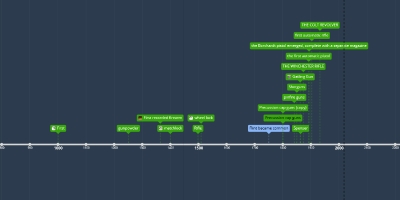31 dic 1857 anni - indian rebillion of 1857
Descrizione:
The Enfield P53 was introduced to Indian troops under British colonization in 1856.[3] The Enfield rifle-musket was used as a contributing cause of the Indian rebellion of 1857. Sepoys in the British East India Company's armies in India were issued with the new rifle in 1857, and rumours were spread that the cartridges (referring here to paper-wrapped powder and projectile, not to metallic cartridges) were greased with beef tallow, pig fat, or a combination of the two - a situation so abhorrent to Hindu and Muslim soldiers based on religious beliefs.
British military drills of the time required soldiers to tear open by biting open the prepared cartridge, pour the gunpowder contained within down the barrel, ram the cartridge (which included the bullet) down the barrel, extract the ram-rod, bring the rifle to the ready, set the sights, add a percussion cap, present the rifle, and fire. The musketry books also recommended that, "Whenever the grease around the bullet appears to be melted away, or otherwise removed from the cartridge, the sides of the bullet should be made wet in the mouth before putting it into the barrel; the saliva will serve the purpose of grease for the time being".[4]
The idea of having anything which might be tainted with pig or beef fat in their mouths was unacceptable to the native soldiers, and when they objected it was suggested that they were more than welcome to make up their own batches of cartridges, using a religiously acceptable greasing agent such as ghee or vegetable oil. This seemed to prove that the issued cartridges were, in fact, greased with pig and/or beef fat. A further suggestion that the Sepoys tear the cartridges open with their hands (instead of biting them open) was rejected as impractical - many of the Sepoys had been undertaking musket drill daily for years, and the practice of biting the cartridge open was second nature to them. Incidentally, after the Mutiny, manuals amended the method of opening the cartridge to, "Bring the cartridge to the forefinger and thumb of the left hand, and with the arm close to the body, carefully tear off the end without spilling the powder."[5] The arrogant indifference of many British commanding officers to the problem, a religious consideration as to tolerance, as perceived by the Sepoys only added more fuel to the already volatile situation, and helped spark the rebellion in 1857.
As a consequence of British fears and general irrationality, the native infantry's long arms were modified to be less accurate by reaming out the rifling of the Pattern 1853 making it a smooth bore and the spherical / ball shot does not require greasing, just a patch. This greatly reduced the gun's potent and effectiveness, as did replacing the variable distance rear sight to a fixed sight. This became the Pattern 1858. However, due to the now thinner walls, the barrel would bulge and bursting was not an unknown problem. Furthermore, with the bayonet fitted excessive flexing became an issue. To remedy this, an urgent order was placed in England for around 12,000 new barrels made specifying with a thicker barrel wall. This became the very scarce Enfield Pattern 1859 which in good to v.good condition attracts a premium.
Aggiunto al nastro di tempo:

GUns
Data:
Geo:
